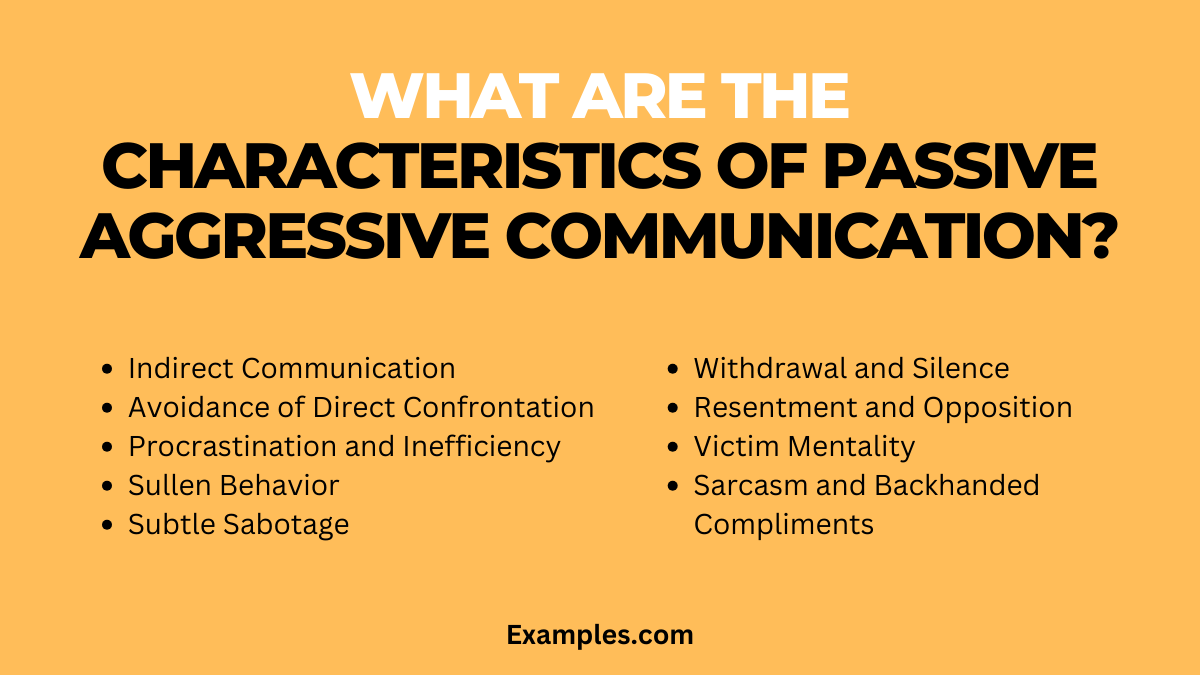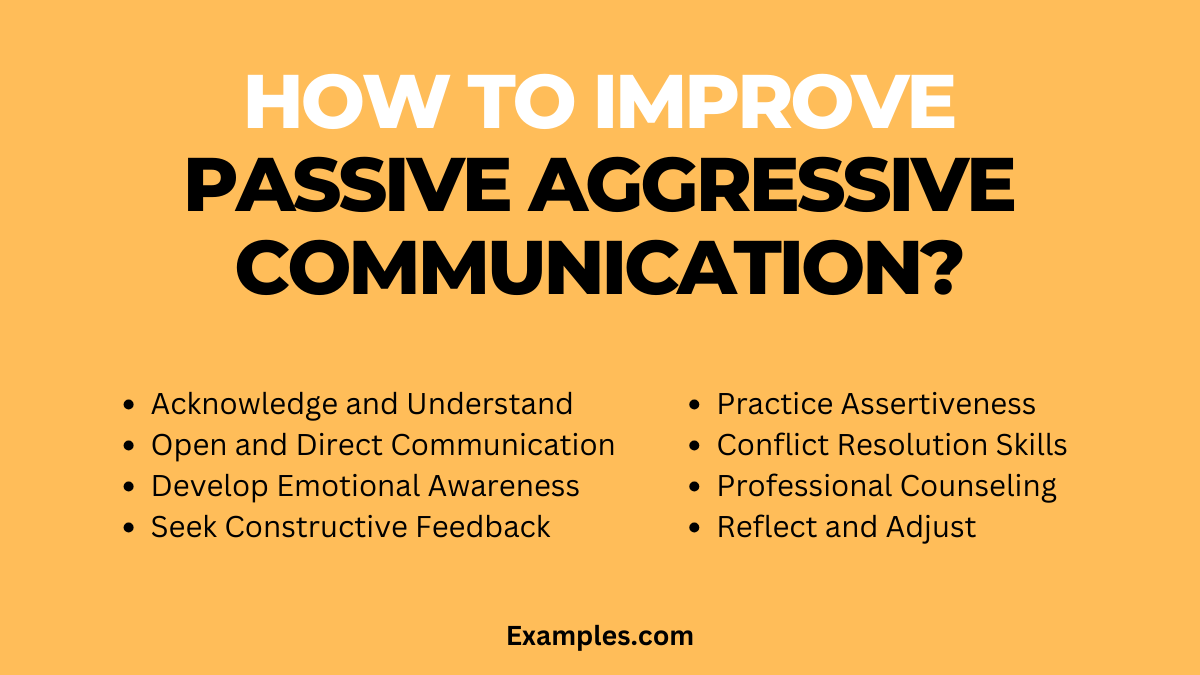20+ Characteristics of Passive Aggressive Communication Examples
Explore the nuanced world of passive-aggressive communication with our in-depth guide. This resource unveils the subtle yet impactful characteristics of this communication style, often masked by indirect expressions and hidden meanings. Dive into real-life examples that illustrate how passive-aggressiveness manifests in everyday interactions, both personally and professionally. Understand the underlying motivations and effects of this behavior to enhance your communication skills and navigate complex social dynamics with confidence. This guide is essential for anyone seeking to identify and address passive-aggressive patterns in their relationships.
What are the Characteristics of Passive Aggressive Communication?

Passive-aggressive communication is a complex behavior pattern where an individual expresses negative feelings subtly instead of openly discussing them. Recognizing these characteristics is essential in both personal and professional interactions. Here are some key characteristics:
- Indirect Communication: Instead of stating their needs or issues directly, passive-aggressive communicators tend to use indirect methods. This might include hinting, implying, or using sarcasm instead of straightforwardly expressing their thoughts.
- Avoidance of Direct Confrontation: These individuals usually avoid direct confrontation. They might agree to a request but subsequently act in opposition or simply not follow through.
- Procrastination and Intentional Inefficiency: They often delay tasks or perform them inadequately as a form of resistance, especially if they feel pressured or cornered.
- Sullen Behavior: Displaying sullenness, such as being uncommunicative or morose, is a common characteristic. This is often used to express displeasure without engaging in open conflict.
- Subtle Sabotage: They might subtly undermine tasks or relationships. This could manifest as conveniently forgetting commitments or making mistakes that impede progress.
- Withdrawal and Silence: A passive-aggressive person might use the silent treatment as a form of control or to express discontent.
- Resentment and Opposition: Underneath the surface, there’s often a current of resentment. Their actions, though not overtly hostile, can be contrary to what they verbally agree to.
- Victim Mentality: They often perceive themselves as misunderstood or underappreciated, and they may vocalize these feelings through veiled statements or behaviors.
- Sarcasm and Backhanded Compliments: Using sarcasm or giving compliments that actually contain a critical edge are common tactics.
Identifying these characteristics in communication can be crucial for addressing and managing interpersonal challenges effectively. Understanding the underlying reasons for such behavior, like fear of conflict or feelings of powerlessness, can also be key to finding constructive solutions.
What are the Characteristics of a Passive Aggressive Person?
Understanding the characteristics of a passive-aggressive person can be crucial in navigating both personal and professional relationships. Passive-aggressive behavior typically involves indirect resistance to requests or demands and avoidance of direct confrontation. Here are some key characteristics:
- Indirect Resistance: A passive-aggressive individual often resists tasks or demands indirectly. Instead of openly refusing, they may procrastinate, forget, or perform tasks inefficiently.
- Avoidance of Direct Communication: These individuals avoid direct communication, especially in conflict situations. They tend to express their negative feelings subtly rather than openly discussing them.
- Sarcasm and Backhanded Compliments: Sarcasm is a common tool. They might use backhanded compliments to mask their true feelings under the guise of humor.
- Feelings of Resentment: Passive-aggressive people often harbor feelings of resentment and feel misunderstood or underappreciated. This resentment may not be expressed openly but can manifest in their behavior.
- Fear of Intimacy: They might struggle with intimacy and closeness due to a fear of vulnerability. This can lead to issues in personal relationships.
- Victimization: A tendency to perceive themselves as victims of unfair circumstances or treatment is common. They may use this perceived victimization to justify their behavior.
- Resistance to Change: Often, passive-aggressive individuals are resistant to change, especially if it’s imposed by others. They may outwardly agree to changes but internally resist or sabotage them.
- Difficulty with Anger: They typically have difficulty expressing anger directly. This can lead to pent-up frustration that is expressed through passive-aggressive actions.
- Manipulative Behavior: Their actions can be manipulative, designed to get what they want without having to ask for it directly.
- Denial: When confronted, they often deny having negative feelings or being passive-aggressive. This denial can make addressing the behavior challenging.
Understanding these characteristics is vital for effective communication and conflict resolution with passive-aggressive individuals. It’s important to approach such situations with patience and empathy, aiming to encourage open and honest communication.
What are Passive Aggressive Communication Styles?
Passive aggressive communication styles are a subtle, indirect way of expressing negative feelings instead of directly addressing them. This style often manifests in behaviors that appear outwardly passive, but harbor underlying aggression. It’s characterized by actions like:
- Sarcasm and Subtle Insults: Communicating displeasure through sarcastic remarks or veiled insults, often under the guise of humor.
- Silent Treatment: Withholding communication as a means of control or punishment.
- Procrastination and Avoidance: Intentionally delaying tasks or avoiding responsibilities to express opposition or resentment.
- Subtle Sabotage: Hindering progress on tasks or objectives to indirectly express anger or disagreement.
- Feigned Helplessness: Pretending inability to do a task to avoid responsibility or to gain sympathy.
- Backhanded Compliments: Offering compliments that contain a critical or negative undertone.
These styles can be challenging to identify and address because they blend passive behavior with underlying aggression, creating a complex communication dynamic. Understanding these patterns is crucial for fostering healthy and direct communication in both personal and professional settings.
How to Improve Passive Aggressive Communication?

Here are instructions to follow to improving Passive Aggressive Communication:
- Acknowledge and Understand Passive Aggressive Behaviors: Recognizing patterns of passive-aggressive communication is the first step toward improvement. Identify behaviors like indirect expression of hostility or resentment.
- Open and Direct Communication: Encourage open dialogue. Be clear and straightforward in expressing thoughts and feelings, reducing the ambiguity often associated with passive-aggressive behavior.
- Develop Emotional Awareness: Improving self-awareness about emotions can lead to healthier expression of feelings. It’s important to understand and acknowledge emotions rather than suppressing them.
- Seek Constructive Feedback: Actively seeking feedback can provide insights into how one’s communication style is perceived by others.
- Practice Assertiveness: Learn to express needs and wants confidently and directly, without aggression or passivity. Assertiveness training or workshops can be beneficial.
- Conflict Resolution Skills: Develop skills to address and resolve conflicts in a healthy and constructive manner. This can help prevent passive-aggressive tendencies that often arise from unaddressed grievances.
- Professional Counseling or Therapy: If passive-aggressive behavior is deeply ingrained, professional help such as counseling or therapy can provide strategies for change and improvement.
- Reflect and Adjust: Continuously reflect on interactions and be willing to adjust communication strategies. This involves being mindful of one’s words and actions and their impact on others.
Tips for Dealing with Passive Aggressive Communication
Dealing with passive-aggressive communication can be challenging. Here are some effective strategies:
- Stay Calm and Objective: When you encounter passive-aggressive behavior, maintaining a calm and composed demeanor is crucial. Reacting emotionally can escalate the situation.
- Use Clear and Direct Communication: Address the issue head-on by using clear and direct language. Avoid ambiguity or beating around the bush.
- Set Boundaries and Consequences: Establish firm boundaries. Make it known that passive-aggressive behavior is unacceptable and outline the consequences if it continues.
- Encourage Open Dialogue: Create an environment where open and honest communication is encouraged. This can help the passive-aggressive person feel safe to express their thoughts and feelings directly.
- Don’t Take It Personally: Remember that passive-aggressive behavior often stems from the individual’s own struggles and insecurities. Try not to take their behavior personally.
- Seek to Understand: Try to understand the root causes of their behavior. This empathy can guide your response and help in resolving underlying issues.
- Provide Positive Reinforcement: When the individual communicates in a healthy and direct manner, acknowledge and reinforce this behavior positively.
- Consider Professional Help: In some cases, professional counseling or therapy might be necessary, especially if passive-aggressive behavior is deeply ingrained or causing significant issues.
By implementing these tips, you can more effectively navigate and mitigate the challenges posed by passive-aggressive communication, ultimately leading to more productive and less stressful encounters. Remember, the goal is to foster a healthier communication dynamic.
In conclusion, understanding the characteristics of passive-aggressive communication is crucial for healthy interpersonal interactions. Recognizing signs like indirectness and sarcasm, and adopting strategies such as clear communication and focusing on solutions can mitigate the negative impact of this communication style. It’s important to foster open and assertive communication to encourage honesty and clarity in all forms of interaction, whether in personal relationships or professional settings.



